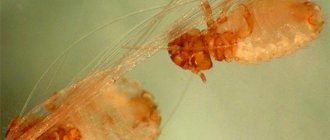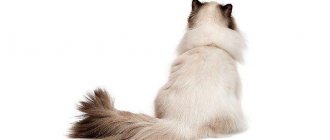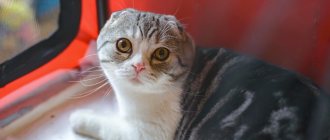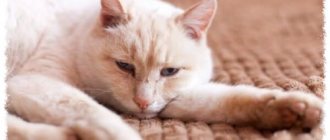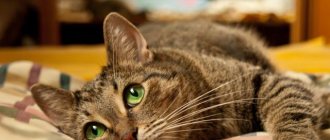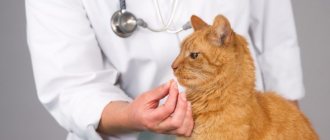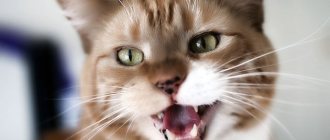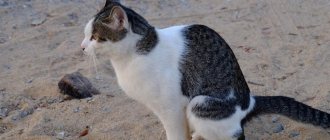Cats are very hygienic animals and spend most of their day clean. However, we should notice if they spend too much time grooming one area. If we see them licking their private areas almost constantly, we need to take a look. One of the reasons for this repetitive grooming may be due to a red and swollen butt. The first cause of this inflammation that we might think of is rectal prolapse, but it is important to know that there are several reasons why a cat's butt is red, many of which should be temporary.
We look at what happens when a cat has a swollen and red anus. We discuss possible causes and also find out what treatment can help your cat get rid of its problem.
Causes
Since there are no hair follicles in a cat's anal and rectal tissue, we can easily see them when the cat raises its tail. A healthy cat's butt should be light pink and look healthy. If it's too pale, it could be a sign of a problem. This is more difficult to detect than a swollen anus. When a cat's butt is swollen, it will likely be a different color, usually red or purple.
Inflammation of the anus and rectal mucosa is known as proctitis. Idiopathic proctitis occurs when there is no apparent cause, but a swollen and red butt is likely caused by one of the following:
© shutterstock
- Diseases of the gastrointestinal tract
- Tumors
- Inflammatory infection
- Obstructed anal glands
- Allergic reaction
- Foreign object
- Parasites
- Colitis
It is important to note the difference between a swollen butt and rectal prolapse. Rectal prolapse occurs when rectal tissue comes out through the anus. Although the anus will likely swell during this process, this is a secondary symptom of prolapse. Because prolapse is usually caused by a condition that requires the cat to strain to defecate, it is possible that the cat's anus will become swollen before this occurs.
The problem of anal inflammation in cats should be addressed, but in most cases it is not a serious problem and is usually fairly easy to treat. Rectal prolapse is considered a veterinary emergency and requires immediate attention.
Below we detail the main reasons why a cat has a swollen and red bottom.
Signs
The sacs, filled with fluid, increase in size and become inflamed. Sometimes this leads to the development of an abscess - purulent inflammation with ulcers and fistulas.
Enlarged glands do not allow the animal to defecate freely, sometimes reaching such volumes that it has difficulty walking.
Inflammation of the paraanal glands in a cat can be detected if you carefully monitor your pet’s behavior: she often licks under her tail, as if gnawing out parasites there, and fidgets on the floor with her butt, trying to squeeze out the secretion. After a while, the animal smells so strongly that just being near it becomes very difficult.
But that’s not all that clogged cat’s paraanal glands lead to. Symptoms of inflammation may be as follows:
- Heat.
- Severe deterioration in health.
- Refusal to eat.
Lack of treatment leads to death from blood poisoning. Bringing a sick animal to this stage is the height of irresponsibility!
Diseases of the gastrointestinal tract
The most common cause of anal inflammation in cats is some kind of gastrointestinal disease. It is an umbrella term for a variety of disorders that vary in symptoms and severity. Because it affects the digestive tract, it is often associated with what the cat eats, but not exclusively.
One of the common problems that cause gastrointestinal upset is poor diet. This may be because the cat is being fed poor food or the diet she is eating is not appropriate for her health. An improper diet often leads to diarrhea, like many other diseases of the gastrointestinal tract. This is one of the reasons why your cat may have a red butt or leak fluid.
Whether the stool is too soft or hard, your cat may irritate the anus, causing swelling. Loose stool can also accumulate around the anus, promoting bacterial growth and causing inflammation. However, constipation can also cause stimulation of the anus. If the stool is too large or hard, the strain puts pressure on the anus and causes swelling.
Treatment for this problem will depend on the cause of the gastrointestinal disease. If it's diarrhea, your cat may need more fluids to combat dehydration; if it's constipation, she may need fiber. Age also affects treatment.
Who is susceptible to the disease
Most often, the pathology is observed in young males, but it is not uncommon for cats to suffer from this problem. Inflammation is especially common among long-haired animals.
In addition, the following animals are at risk:
- leading a sedentary lifestyle;
- pregnant cats;
- injured in the anus;
- those who eat poorly and are prone to diarrhea or constipation;
- with obesity.
Anal tumors
Tumors are a type of growth that can develop on almost any part of the body, including the butt. Some are malignant, others are benign. However, even benign growths can cause suffering for a cat, especially if they are on the butt. They can negatively affect their ability to defecate and cause serious irritation.
Because your cat's anus is exposed to sunlight, it is possible that she may become infected with a skin cancer known as melanoma. However, squamous cell carcinoma most often affects a cat's anus. Fortunately, any type of anal cancer in cats is rare. If there are tumors on the butt or rectum, most likely these are benign tumors.
Treatment for any type of tumor will depend on its cause. Surgery is usually required. If the tumor is malignant, a combination of surgery, chemotherapy and/or radiation therapy may be required. The prognosis will depend on whether the cancer has metastasized to other parts of the cat's body.
Behavioral instincts
Most cats turn out to be real clean people and are willing to spend a lot of time licking their fur. This behavior is driven by natural instincts:
- Cleaning up after the hunt. Cats are predators, so after meals they need to remove the blood of their “prey” from their coats.
- Calming effect. This procedure calms the animal and relieves stress. It is believed that by cleaning the fur with their tongue, cats lick vitamin B from it, which is necessary for normalizing psychological balance.
- Method of camouflage. Washing is not just a standard ritual; cats use it to mask their scent. This allows wild animals to remain undetected for as long as possible during the hunt.
- Protective reflex. With their rough tongue they distribute fatty lubricant - secretory lard, which protects the coat and gives it elasticity.
- Purity. Licking is also a hygienic procedure, as a result of which cats keep their fur clean, including in the intimate area.
Fur coat length. As a rule, hairless and short-haired pets are easier to care for their skin and coat. But the owners of a luxurious, long fur coat are less fortunate. Often, access to “that very” place is difficult for them. And if a long-haired pet suddenly begins to “ride” along the floor on the “fifth point”, choosing rough surfaces, then it is worth looking under its tail and assessing the condition of the fur in this place. Perhaps dirt, fecal particles have stuck to it, tangles have appeared, or foreign objects, such as plant twigs, have become stuck.
Inflammatory infection
If your cat has a viral, bacterial or fungal infection, a swollen and red butt may be one of the symptoms. The types of these infections are incredibly varied, but they can be systemic or local.
With local infections, the cat may have a bacterial infection. If your cat's anus is injured due to strain or any other physical trauma affecting the area, bacteria will likely enter the wound. This often occurs through cat feces. Bacteria causing the infection can cause inflammation. If the infection is severe enough, your cat will need antibiotic treatment.
Typically, treatment will depend on the cause. In rare cases, antiviral drugs may be used for viral infections. Most often, treatment requires symptom relief until the body recovers.
© shutterstock
Treatment of paraanal inflammation
The main method of treating paraanal inflammation in cats is mechanical squeezing of accumulated secretions from the paraanal sinuses. There are several methods.
Before you begin, you must wash your hands and put on gloves. Next, you need to put pressure on the paraanal glands by putting gauze napkins on them first. It is necessary to use this method only if the secretion has retained its liquid form.
The next method is internal. After washing your hands first, insert your index finger into the cat's anus. And with your thumb, gently press on the outside of the gland to release the secretion. This method can help when the anal sinuses are filled with thick secretions.
If the cleansing process takes place in a laboratory laboratory setting, then after the glands have been cleansed, they are washed with antiseptics using a catheter.
The doctor may also prescribe antibiotics. The cat is given a rectal suppository against inflammatory processes. Usually the effect is noticeable a few days after these manipulations.
In exceptional cases, procedures are resumed several more times.
If the animal does not allow this procedure to be carried out due to pain in the area of inflammation, then the sick cat is given an anesthetic drug. After which manipulations are carried out.
Seizures in cats - main causes, symptoms, first aid, treatment and choice of drugs (110 photos)Polycystic kidney disease in cats - causes, diagnosis and symptoms of the disease. Treatment options and prevention of kidney disease (95 photos)
Tartar in cats - signs of the disease and methods of fully treating tartar (125 photos + video)
Obstructed anal glands
A cat's anal glands are located near the anus. These glands are designed to both lubricate the anus during bowel movements and release scent to mark territory. Pheromones secreted by the anal glands (also known as anal sacs) help other cats identify them and learn information about them. Although this problem does not directly affect the butt, the location of the anal glands can cause the butt to become swollen and red.
Blockage of the gland duct can lead to the so-called anal sac disease. This means that the glands are exposed to secretions, often due to the accumulation of dirt. Especially in older cats, it is common for a caregiver or veterinarian to manually isolate the anal glands. If they don't, blockage occurs and a secondary infection develops. In extreme cases, this can lead to a painful abscess.
Washing
This procedure can only be performed by a specialist. It is indicated for significant inflammation, when there is suppuration and a through hole is formed.
It is important to know that treatment at this stage will take a long time, and recovery is not guaranteed. You will have to resort to the procedure constantly in order to at least slightly reduce the animal’s pain.
Washing consists of the following steps:
- preparing and filling an antiseptic solution into a syringe;
- pouring liquid into the hole;
- repeat the procedure until the clearest liquid flows out;
- treatment with an antimicrobial agent.
To prevent the cat from licking itself, a collar, diaper or blanket is put on it.
Allergic reaction
As we emphasized earlier, the butt consists of a certain type of skin tissue. As with other skin tissues, an allergic reaction may occur upon contact with the relevant allergen. Since the anus is on the cat's back, the problem is most likely to arise when the cat sits on something that contains an allergen.
An example would be a cat's sensitivity to a certain ingredient in a cleaning product. If the floor has just been cleaned with this product, your cat may develop contact dermatitis. The butt may become inflamed and red. In these cases, the veterinarian will likely rule out other possible causes first. The elimination process can then be carried out until the correct allergen is found.
Development
Inflammation of the paraanal glands in a cat has a very simple mechanism of development.
First of all, the natural outflow of secretions is disrupted, as a result of which the sinuses become overfilled. After this, the liquid in the sacs becomes thick, which leads to itching - the inflammatory process begins. Irritation accelerates the growth of microflora. The affected area increases, an abscess forms and the wall of the gland breaks through. By this time, the cat's condition becomes unsatisfactory, and the temperature may rise significantly.
A disease that has reached this stage can even kill the animal. Treatment must be started as quickly as possible. In addition, it is important to remember that purulent inflammation of the paraanal glands in a cat is almost impossible to treat, and therefore becomes chronic.
Possible pathological disorders
Unfortunately, diarrhea and dirty fur are not the only factors that cause a cat to ride on its butt. There are also more serious factors that lead to this behavior, for example:
- mental health disorder;
- post-traumatic stress disorder;
- helminthic infestation;
- paraanal inflammation.
Each of the diseases deserves attention and requires consultation with a veterinarian. In addition, they are accompanied by other symptoms, in addition to “travels on the fifth point”.
The owner may notice that the pet begins to crawl on the floor, regardless of toilet procedures. In this case, it is recommended to immediately contact a specialist who will identify the pathology and prescribe appropriate therapy.
After an injury to the hind legs or a fracture of the hip joint, the pet begins to look for a way to eliminate phantom soreness. He rolls on the floor, trying to get rid of the pain that is lingering in his brain. In such a situation, veterinarians prescribe medications that have a mild sedative effect to the animal. They help him cope with excruciating post-traumatic discomfort.
Most often, pets get pinworms and tapeworms, which live in the large intestine. To reproduce, many of them have to crawl to the entrance to the anus to lay eggs. This process is accompanied by a feeling of severe itching, which the pet tries to get rid of by crawling on the floor.
When infected with tapeworms, a feeling of bloating occurs in the intestines. The cat strives to get rid of feces, stimulating the anus while riding on the floor and causing defecation. To save your pet from such difficulties, you should regularly deworm it, using anthelmintic drugs for preventive purposes. These can be tablets for oral administration, drops on the withers area or other means.
Mustachioed striped animals have anal glands, which are muscular sacs located in close proximity to the anus. They constantly produce secretions that are released through the ducts during bowel movements. It gives feces and urine a specific odor, allowing cats to leave “fragrant” marks on their territory.
Norm and deviations. In its normal state, the secretion is a thick, odorous substance. If the glands are not completely emptied, then corresponding disorders arise:
- the tissues of the muscle sacs are “overstretched”;
- irritation occurs in the glandular ducts;
- dermatological problems arise - small inflamed seals and bald spots form in the neck and along the spine;
- the paraanal glands swell greatly and become visible under the animal’s tail.
Consequences. If the owner does not pay attention to the blockage in time, then the disruption of circulation ends with the formation of a fistula and the penetration of the contents of the glands into the peritoneum.
Prevention of panleukopenia in cats
The main measure to prevent the disease is vaccination. Kittens are recommended to be vaccinated when they reach 8–9 weeks of age. Then after a month and the next revaccination after a year. Adult cats should be vaccinated annually. Many domestic and foreign vaccines have been developed for active immunoprophylaxis. For example, Multifel-4, Parvovaccarnivorum, Quadrikat, Leukorifelin and others.
General preventive measures include compliance with feeding standards and sanitary rules for keeping cats. In addition, it is better to purchase kittens from reliable, responsible breeders, and quarantine after purchase. And we should not forget that preventing a disease is much easier than treating it!
Diagnostics and first aid
If your cat poops blood, don’t hesitate. Only after a comprehensive examination is it possible to draw up an accurate treatment plan, so it is important to turn to professionals. Before contacting the clinic, the owner of the animal should carefully observe the cat in order to describe the clinical picture and symptoms as accurately as possible before visiting the veterinarian.
The history must indicate the frequency of bowel movements in the animal and how many times blood fractions were present in the feces. It is also important to consider whether the feces contained blood and mucus, or whether there were undigested food particles. Perhaps the blood was released in the form of drops or clots.
The behavior of the animal during the act of defecation also matters. If during the act of defecation the pet screams and tenses, this may indicate constipation or a tumor that interferes with the normal passage of feces.
It is also necessary to note the accompanying symptoms - the presence of vomiting, refusal to eat, diarrhea, thirst or refusal of water. The appearance of bloody diarrhea in a pregnant cat is often accompanied by an increase in body temperature, a sharp decrease in activity, vomiting and apathy.
Referring to the data received from the animal owner, as well as after a clinical examination, the veterinarian prescribes additional diagnostic methods to determine the cause of the appearance of blood in the cat’s feces. In all cases, diagnosis includes:
- conducting a general blood test;
- blood from a vein for biochemistry;
- coprogram (necessary for analyzing the properties of feces of physical and chemical types).
Additional diagnostic methods are:
- ultrasound examination of the abdominal organs;
- colonoscopy (required if there is a suspicion of obstruction of the large intestine, the presence of polyps or tumors);
- urine analysis;
- allergy tests (if food allergies are suspected);
- X-ray of the abdominal organs.
Based on the results of the research, a qualified doctor develops a treatment regimen, taking into account the individual characteristics of the animal and the complexity of the pathological process.
Why does a cat ride on its butt: finding out the causes of the malaise
Puberty of a furry pet ends with the first heat. For everyone, this happens at its own time, but, as a rule, before the age of one.
Veterinarians note that a cat may first begin to raise her rear end and desire to reproduce between 6 and 10 months of age.
That’s when it’s hard for the owner not to understand what’s going on. With the first heat, there comes a period when this behavior will occur regularly. There are a number of signs that make it clear that a person wants a cat for the first time.
Despite the comical nature of the situation when a cat rides on its butt, you should not laugh, but look for the cause of your pet’s illness. Of course, not every owner will immediately realize that the strange behavior of the four-legged animal is associated with severe discomfort... and will watch the “ride” for some time. When seizures become frighteningly frequent, anxiety will come, but let’s make a reservation right away: whatever the reason, there is no mortal threat behind this symptom.
When describing your anamnesis, you need to take into account that the desire to ride on your butt on the floor is always caused by severe itching. Due to its constitution, the cat cannot honor the causal place with its paws and gets out of the situation differently. In the initial stages, neither the owner nor the veterinarian will be able to identify the cause, at least visually. Since the condition does not require immediate intervention, it is recommended to act step by step, eliminating the causes one by one.
Most of the reasons that make your pet want to lie on its back are completely harmless, but you may encounter a problem that requires treatment.
The most common reasons why a cat rolls on its back are:
- 1. The desire to scratch your back. The animal is not able to reach its back with its paws, so it has to periodically lie on its back to scratch itself.
- 2. Manifestation of instincts or just a game. In the cat family, unlike dogs, the dominant one in the pair falls on his back. From the outside it may seem that he is defeated, but in fact this is how the animal gets the opportunity to inflict a strong blow on the enemy with its hind legs. When a cat is playing and rolling on the floor on its back, you should not reach out to it, it will take it as a challenge and attack. Even if the pet is just playing, sharp claws can seriously hurt, so at such moments you need to be careful around the animal.
- 3. Sexual hunting. If the animal does not have breeding value, experts recommend sterilization. This is due to the torment that the pet experiences every time due to strong hormonal changes, and with a high risk of diseases of the genitourinary system. It has been proven that sterilized cats live up to 3 years longer than those who regularly go into estrus, that is, do not become pregnant at the right time.
- 4. Relaxation and stress management. Some cats behave this way to calm down and may roll on their back after a slight fright or mild stress, getting rid of it in this way. This is considered normal if the pet does not experience significant discomfort and is not tense.
- 5. Foreign odor that the animal tries to eliminate with its own. Then the cat rubs its back not only against the floor, but also against various things and objects. As soon as the pet becomes satisfied with the result of its actions, it loses interest in this activity.
We invite you to read the Report on the topic Stag Beetle (description for children)
If your cat's piggyback ride is related to one of these options, there is nothing to worry about. This behavior does not require intervention, much less treatment. An exception can be considered sterilization, but this is not a mandatory method, but a recommendation from specialists. This way it will be calmer for all household members and the cat itself, because even if the animal does not meow loudly, it suffers.
- 2. Felted fur causes a lot of inconvenience to the animal. Long-haired cat breeds suffer from this constantly, so regular brushing is essential. But pets with short hair do not always cope on their own, especially in the back area. To solve the problem, just choose the most suitable comb and regularly remove excess hair. With this care, the cat will swallow less hair, which will have a positive effect on its digestive system.
- 3. Infections with various forms of fungi can cause itching and rolling on the back. It is impossible to find out which type of infection has affected the animal without tests, so self-treatment in this case is unacceptable. Depending on the degree of development of the disease, local therapy or complex treatment is selected. The risk of fungal infection is high, even if the pet does not leave the house.
Each of the possible causes requires timely intervention in order to relieve the animal from discomfort as quickly as possible. If treatment is necessary, consultation with a veterinarian is mandatory. It is almost impossible to choose the most effective drug for a cat at home, and treatment at random often causes various complications.
These are usually questions that new pet owners ask. Noticing that the cat is rubbing the back of its body on the grass, carpet, or parquet, the owners are perplexed. What causes this body movement? What could this indicate? Let's look into it in detail.
